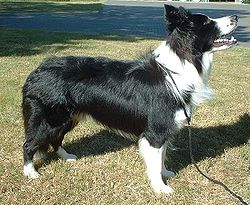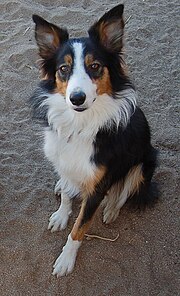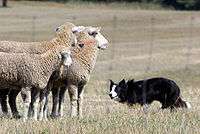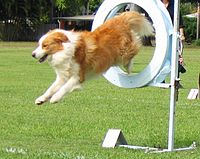Border Collie
From Wikipedia, the free encyclopedia
 Border Collie |
|||||||||||||||||||||||||
| Country of origin | UK - Scotland / England / Wales | ||||||||||||||||||||||||
|---|---|---|---|---|---|---|---|---|---|---|---|---|---|---|---|---|---|---|---|---|---|---|---|---|---|
|
|||||||||||||||||||||||||
|
|||||||||||||||||||||||||
The Border Collie is a breed of herding dog that originated along the borders of England, Wales and Scotland. They are widely regarded as the most intelligent dog breed.[1][2] These highly energetic dogs are often considered the world's best sheep herding dogs,[3] and are frequently used on farms all over the world for assisting with the handling of livestock. While originally bred for farm work, they have also become popular as pet and sport dogs. These dogs can be protective of a human family member and are, most of the time, affectionate to those they know. Border Collies are easily trained but need a lot of physical exercise and mental stimulation.
Contents |
[edit] Description
[edit] Appearance
In general, Border Collies are medium-sized dogs without extreme physical characteristics and a moderate amount of coat. Their double coats can be anywhere from slick to lush, and can come in many colors, although black and white is by far the most common. Black tricolor (black/tan/white or sable and white), red (chocolate) and white, and red tricolour (red/tan/white) also occur regularly, with other colors such as blue, lilac, red merle, blue merle, brindle and "Australian red"/gold seen less frequently. Border Collies of any color with no white markings are also seen.[citation needed]
Eye color varies from deep brown to amber or blue with occasionally one eye of each color, usually seen with merles. The ears of the Border Collie are also highly variable — some have fully erect ears, some fully dropped ears, and others semi-erect ears (similar to that of the Rough Collie or sighthounds). Although working Border Collie handlers sometimes have superstitions about the appearance of their dogs (handlers avoid mostly white dogs due to old wives tales about sheep not respecting them),[citation needed] in general a dog's appearance is considered to be irrelevant. It is considered much more useful to identify a working Border Collie by its attitude and ability than by its looks.
Those dogs bred for the conformation ring are more homogeneous in appearance than working Border Collies, since to win in conformation showing they must conform closely to breed club standards that are specific on many points of the structure, coat and color. Kennel clubs specify, for example, that the Border Collie must have a "keen and intelligent" expression, and that the preferred eye color is dark brown. In deference to the dog's working origin, scars and broken teeth received in the line of duty are not to be counted against a Border Collie in the show ring.
Height at withers: Males from 19" to 22" (48 cm to 56 cm), females from 18" to 21" (46 cm to 53 cm). (See various breed standards for details.)
[edit] Temperament
Border Collies are an intelligent breed with an instinctive desire to work closely and intensely with a human handler. They are very well behaved but can be very excitable dogs.These dogs fit well into any family. If your family is active the dog will be but if your family isn't as active then the dog will adjust as long as it still gets daily exercise. [4] Although the primary role of the Border Collie is that of the working stock dog, dogs of this breed are becoming increasingly popular as pets. True to their working heritage, Border Collies make very demanding, energetic pets that are better off in households that can provide them with plenty of exercise and ample play with humans or other dogs. Border collies are happiest usually when they have a job to do. However, a job to a border collie isn't necessarily working live stock. An activity such as Frisbee, chasing and retrieving a ball, to name just a few will suffice. As long as the Border collie is in the herding/working position, (Crouched down, tail tucked between legs, eyes firmly fixed on the matter in hand), it considers it work. Border Collies are now also being used in showing, especially agility, where their speed and agility comes to good use[5] which makes dog sports popular with Border Collie owners.[6] However, in an appropriate home, with a dedicated, active owner, a Border Collie can be an excellent companion.[7]
Though they can be a wonderful choice for some households, Border Collies are not perfect pets for all people. For example, as with many working breeds, Border Collies can be motion-sensitive and may attempt to control the movements of family members, cats, bicycles, cars, or anything else that moves if not given enough mental and physical stimulation. These dogs are also generally not suitable for households with small children. Many Border Collies that end up in shelters or rescue groups are there because owners, who may have been attracted by their appearance and intelligence, were not prepared to meet their dog's needs.[8]
[edit] Health
[edit] Lifespan
Based on a sample of 106 deceased dogs, the median longevity of Border Collies is 12 years and 3 months (minimum 2 months, maximum 17 years, 4 months)[9]. The median longevities of breeds of similar size are usually 12 to 13 years[10], so, if the sample was representative of the population, Border Collies have a typical life span for a breed their size.
Leading causes of death were cancer (23.6%), old age (17.9%) and cerebral vascular afflictions (9.4%)[9].
[edit] Common health problems
Hip dysplasia, Collie eye anomaly (CEA), and epilepsy are considered the primary genetic diseases of concern in the breed at this time.[11] CEA is a congenital, inherited eye disease involving the retina, choroid, and sclera that sometimes affects Border Collies. In Border Collies, it is generally a mild disease and rarely significantly impairs vision. There is now a DNA test available for CEA[12] and, through its use, breeders can ensure that they will not produce affected pups. There are different types of hip testing available including OFA (Orthopedic Foundation for Animals) and PennHip. Radiographs are taken and sent to these organizations to determine a dog's hip and elbow quality.
Elbow dysplasia or osteochondritis, deafness, and hypothyroidism may also occur in the breed. Dogs homozygous for the merle gene are likely to have eye and/or hearing problems.
Neuronal ceroid lipofuscinosis (NCL) is a rare but serious disease that is limited to show Border Collies. NCL results in severe neurological impairment and early death; afflicted dogs rarely survive beyond two years of age. The mutation causing the form of the disease found in Border Collies was identified by Scott Melville in the laboratory of Dr. Alan Wilton of the School of Biotechnology and Biomolecular Sciences, University of New South Wales.[13] There is no treatment or cure, but a DNA test is now available to detect carriers as well as affected dogs.
Trapped neutrophil syndrome (TNS) [14] is an inherited autosomal recessive disease which results in mature neutrophils being unable to migrate from the bone marrow into the blood stream.[15] Puppies affected with this disease usually succumb to infection. Because TNS is an immune deficiency, the puppies can present a variety of symptoms depending upon the type of opportunistic infections they contract; as a result, TNS has largely gone undiagnosed in the past. Once thought to be rare, TNS is now believed to be responsible for many cases of "fading puppies". The mutation responsible for TNS is also only found in show dogs, and was identified by Jeremy Shearman in the laboratory of Dr. Alan Wilton of the School of Biotechnology and Biomolecular Sciences, University of New South Wales. There is no cure, but a DNA test is now available to detect carriers as well as affected dogs. [16]
[edit] History
[edit] Origins

The Border Collie is descended from droving and gathering breeds originating on the Scottish, Welsh and English borders, including the Cumberland Sheepdog. Mention of the "Collie" or "Colley" type first appeared toward the end of the nineteenth century, with every current Border Collie tracing back to a dog known as Old Hemp. Old Hemp, a tri-color dog, was born September 1893 and died May 1901. He was bred by Adam Telfer from Roy, a black and tan dog, and Meg, a black-coated, strong-eyed bitch. Hemp was a quiet, powerful dog that sheep responded to easily. Many shepherds used him for stud and Hemp's working style became the Border Collie style.
Wiston Cap is the dog that the International Sheep Dog Society (ISDS) badge portrays in the characteristic Border Collie herding pose. He was the most popular stud dog in the history of the breed, and appears in a huge percentage of pedigrees today. Bred by W. S. Hetherington and trained and handled by John Richardson, Cap was a biddable and good-natured dog. His bloodlines all trace back to the early registered dogs of the stud book, and to J. M. Wilson's Cap, who occurs sixteen times within seven generations in his pedigree. Wiston Cap sired three Supreme Champions and is grand-sire of three others, one of whom was E. W. Edwards' Bill, who won the championship twice.
These dogs were traditionally known simply as "collies," but terms like working collie, old-fashioned collie, and farm collie have also been applied to them. It was in 1915 that James Reid, Secretary of the International Sheep Dog Society in the United Kingdom, first used the term "Border Collie" to distinguish those dogs registered by the ISDS from the Kennel Club's "Collie," which originally came from the same working stock but had developed a different, standardized appearance following its introduction to the show ring in 1860.[17]
[edit] Breed standards
As is the case with many breeds of dogs that are still used for their original purposes, breed standards vary depending on whether the registry is more interested in a dog that performs its job superbly or a dog whose appearance meets an ideal standard.
There are two types of tests, or standards, to determine the breeding quality of a Border Collie. The original test was the ISDS sheepdog trial, still used today, where a dog and handler collect groups of livestock and move them quietly around a course. The 'standard' comes from the fact that, the world over, there are certain standard elements to this test. Sheep must be gathered without being too much disturbed, from a distance farther than the typical small airport runway. They then must be directed through obstacles at varying distance from the handler, and then the dog must demonstrate the ability to do work close at hand by penning the sheep and sorting them out. It is these elements which have shaped the working abilities of the Border Collie and defined the breed. These dogs are necessarily capable of incredible feats of athleticism, endurance, intense focus, and high levels of trainability.
In nearly every region of the world, the Border Collie is now also a breed which is shown in ring or bench shows. For the people who participate in these events, the Border Collie is defined by the breed standard, which is a description of how the dog should look. In New Zealand and Australia, where the breed has been shown throughout most of the twentieth century, the Border Collie standards have produced a dog with the longer double coat (smooth coats are allowed), a soft dark eye, a body slightly longer than tall, a well-defined stop, as well as a gentle and friendly temperament. This style of Border Collie has become popular in winning show kennels around the world, as well as among prestigious judges. Many enthusiasts, however, oppose the use of Border Collies as show dogs, for fear that breeding for appearance will lead to a decline in the breed's disposition and favorable working dog traits.

Few handlers of working Border Collies participate in conformation shows as working dogs are bred to a performance standard rather than one based on appearance. Likewise, conformation-bred dogs are seldom seen on the sheepdog trial field, except in Kennel Club-sponsored events. Dogs registered with either working or conformation based registries are seen in other performance events such as agility, obedience, tracking or flyball, however these dogs do not necessarily conform to the breed standard of appearance as closely as the dogs shown in the breed rings as this is not a requirement in performance events, nor do they necessarily participate in herding activities.
[edit] Registries
In the UK, there are two separate registries for Border Collies. The International Sheep Dog Society[18] encourages breeding for herding ability, whereas the Kennel Club (UK) encourages breeding for a standardized appearance. The ISDS registry is by far the older of the two, and ISDS dogs are eligible for registration as pedigree Border Collies with the Kennel Club (KC) — but not vice versa. The only way for a Border Collie without an ISDS pedigree to be added to the ISDS registry is by proving its worth as a herding dog so that it can be Registered on Merit (ROM).
In the United States, the vast majority of Border Collies are registered with the American Border Collie Association, which is dedicated to the preservation of the working dog. Historically, there were two other working-centric registries, The North American Sheep Dog Society (NASDS), and the American International Border Collie Association (AIBC).
The breed was also recognised in 1994 by the American Kennel Club (AKC) after occupying the AKC's Miscellaneous Class for over fifty years. The recognition was under protest[19] from the majority of Border Collie affiliated groups, such as the United States Border Collie Club, which felt that emphasis on the breed's working skills would be lost under AKC recognition. AKC registrations have gradually increased since recognition and by the year 2004 there were 1,984 new AKC registrations of Border Collies, with a further 2,378 for the year 2005. By contrast, the American Border Collie Association registers approximately 20,000 Border Collies annually.[20] Because of the inherent tension between the goals of breeding to a working standard and an appearance standard, the American Border Collie Association voted in 2003 that dogs who attained a conformation championship would be delisted from the ABCA registry, regardless of ability. Cross-registration is allowed between the working registries, and AKC accepts dogs registered with ABCA, AIBC and NASDS; but none of the working registries in the U.S. honor AKC pedigrees.
In Australia, Border Collies are registered with an Australian National Kennel Council (ANKC) affiliated state control body or with a working dog registry. Between 2,011 and 2,701 ANKC pedigreed Border Collies have been registered with the ANKC each year since 1986.[21] Inclusion on the ANKC affiliate's main register allows Border Collies to compete in conformation, obedience, agility, tracking, herding and other ANKC-sanctioned events held by an ANKC affiliated club, while inclusion on the limited register prohibits entry in conformation events. The ANKC provides a breed standard, however this applies to conformation events only and has no influence on dogs entering in performance events. Non-ANKC pedigreed dogs may also be eligible for inclusion on an ANKC associate or sporting register and be able to compete in ANKC performance or herding events. Agility organisations such as the Agility Dog Association of Australia (ADAA) have their own registry which allows the inclusion of any dog wishing to compete in their events.
In Canada, Agriculture Canada has recognised the Canadian Border Collie Association[22] as the registry under the Animal Pedigree Act for any Border Collie that is designated as "Pure Breed" in Canada. The criteria used is based on herding lineage rather than appearance. It is a two-tiered registry in that dogs imported that are registered with a foreign Kennel Club that does hold conformation shows are given a "B" registration, whereas those that come directly from other working registries are placed on the "A" registry. Recently, the Canadian Kennel Club has polled its members to decide if Border Collies should be included on the CKC "Miscellaneous List". This designation would allow Border Collie owners the ability to compete in all CKC events, but the CKC would not be the registering body. People who compete in performance events support the move. The CBCA is against this designation.
The registration of working sheepdogs in South Africa is the responsibility of the South African Sheepdog Association. ISDS registered dogs imported into the country can be transferred onto the SASDA register. Dogs not registered can become eligible for registration by being awarded a certificate of working ability by a registered judge. Occasionally they will facilitate the testing of dogs, used for breeding, for Hip dysplasia and Collie eye anomaly to encourage the breeding of dogs without these genetic flaws.
The registration of working Border Collies in Turkey is the province of the Border Collie Dernegi (Turkish Border Collie Association)[23] established in 2007. The president of the association is Dr. Haldun Mergen. The BCD/TBCA is an affiliate of ISDS, and will apply for associate ISDS membership in 2009.
The Border Collie breed is also recognised as the prime sheep dog by the International Stock Dog Federation (ISDF)[24], based in Picadilly, London, UK.
[edit] Activities
[edit] Livestock work
Working border collies can take direction by voice and whistle at long distances when herding. Their great energy and herding instinct are still used to herd all kinds of animals, from the traditional sheep and cattle, free range poultry, and pigs, and ostriches. They are also used to remove unwanted wild birds from airport runways, golf courses, and other public and private areas.
The use of dogs for herding sheep makes good economic sense. In a typical pasture environment each trained sheepdog will do the work that it would take about three human individuals to do if there were no dogs available. In vast arid areas like the Australian Outback or the Karoo Escarpment, the number increases to five or more. Attempts to replace them with mechanical approaches to herding have only achieved a limited amount of success. In general stock handlers find dogs more reliable and more economical.
Shepherds in the UK have taken the most critical elements of herding and incorporated them into a sheepdog trial. The first recorded sheepdog trials were held in Bala, North Wales, in 1873. These competitions enable farmers and shepherds to evaluate possible mates for their working dogs, but they have developed a sport aspect as well, with competitors from outside the farming community also taking part. In the USA, the national sanctioning body for these competitions is the USBCHA.[25]. In the UK it is the International Sheep Dog Society, in Canada the Canadian Border Collie Association (CBCA)[26] and in South Africa it is the South African Sheepdog Association.
[edit] Dog sports
Border Collies excel at several dog sports in addition to their success in herding trials. They dominate the higher jump heights at dog agility competitions, so much so that in England competitions often include classes for ABC dogs, "Anything But Collies". You will also see many Border Collies competing in Flyball.
The Border Collie's speed, agility, stamina have allowed them to dominate in up-and-coming dog activities like flyball and disc dog competitions. Their trainability has also given them a berth in dog dancing competitions.
Border Collies have a highly developed sense of smell and with their high drive make excellent and easily motivated tracking dogs for Tracking trials. These trials simulate the finding of a lost person in a controlled situation where the performance of the dog can be evaluated with titles awarded for successful dogs.
[edit] Search and Rescue
Because of their skills, Border Collies make excellent Search and rescue dogs in Lowland, Mountain, and Urban areas. They have been trained in air-scenting, ground-scenting and as Cadaver Dogs.
[edit] Border Collies of note
- Angelo, Rinoa's pet in Final Fantasy VIII
- Bandit, who was the Ingalls' second dog on Little House on the Prairie.
- Bingo, from the movie Bingo
- Gin, a dancing dog and finalist on the second series of Britains Got Talent along with her owner, Kate Nicholas.
- Rico, who was studied for recognizing up to 200 objects by name.
- 'The Dog', who is the main character in the comic strip Footrot Flats.
- Shep, who was the long-term companion to John Noakes of the BBC's Blue Peter and also Meg, companion of Matt Baker, former presenter of Blue Peter.
- Striker, who is the current Guinness World Record holder for "Fastest Car Window Opened by a Dog" at 11.34 seconds.[27]
- Timmy, the border collie pet of Stefan Foertig.
- Fly and Rex, herding dogs of the movie, Babe.
- Jag, the 23rd Governor of Montana Brian Schweitzer's dog, that regularly accompanies him on work days at the Capitol, as well as some other official occasions.
- Eddie, the household pet of Michael Rawe
[edit] See also
- Cumberland Sheepdog, a breed possibly absorbed into the Border Collie
- McNab (dog), a variety of Border Collie
- Welsh Sheepdog (aka Welsh collie), a close relation to the Border Collie
[edit] References
- ^ Coren, Stanley (2005). The Intelligence of Dogs: A Guide to the Thoughts, Emotions, and Inner Lives of Our Canine Companions (Paperback). The Free Press. ISBN 978-0743280877.
- ^ Kaminski, Juliane; Josep Call, Julia Fischer (June 11, 2004). "Word Learning in a Domestic Dog: Evidence for "Fast Mapping"" (in english). Science (AAAS) 304 (5677): 1682–1683. doi:. ISSN 1095-9203. http://www.sciencemag.org/cgi/content/abstract/304/5677/1682. Retrieved on 2008-07-27. Lay summary.
- ^ "American Kennel Club breed standard". American Kennel Club. 2004-01-13. http://www.akc.org/breeds/border_collie/. Retrieved on 2009-02-09.
- ^ Border Collie Characteristics www.bordercollie.org. Retrieved 2007-08-12.
- ^ BBC - h2g2 - Borda Collies Retrieved 2007-08-12
- ^ Border Collie www.dogbreedinfo.com. Retrieved 2007-08-12.
- ^ BORDER COLLIES AS COMPANIONS Kay Pine, USBCC Newsletter, Winter 1993-94. (Originally published as "Can't We All Get Along?") Retrieved 2007-08-12.
- ^ "Do I Really Want a Border Collie? YES!". 2005-09-18. http://www.bcrescue.org/bcwarning.html.
- ^ a b http://www.thekennelclub.org.uk/item/570 Kennel Club/British Small Animal Veterinary Association Scientific Committee. 2004. Purebred Dog Health Survey. Retrieved 2008-10-31
- ^ http://users.pullman.com/lostriver/weight_and_lifespan.htm Dog Longevity Web Site, Weight and Longevity page. Compiled by K. M. Cassidee. Retrieved 2008-10-31
- ^ Health and Genetics of Border Collies - A Breeder and Buyer's Guide 2002 www.americanbordercollie.org. Retrieved 2007-08-12.
- ^ Collie Eye Anomaly / Choroidal Hypoplasia (CEA) Test www.optigen.com. October 27, 2005. Retrieved 2007-08-12.
- ^ DOG DISEASE GETS THE BITE www.science.unsw.edu.au. Retrieved 2007-08-12.
- ^ TNS Database bordercolliehealth.com. Retrieved 2007-09-05.
- ^ Shearman JR and Wilton AN. Elimination of neutrophil elastase and adaptor protein complex 3 subunit genes as the cause of trapped neutrophil syndrome in Border collies. Animal Genetics. 38: 188-189
- ^ TNS Research Update bordercolliehealth.com. Retrieved 2007-09-05.
- ^ Collie Breed History Lee Weston, www.barkbytes.com. Retrieved 2007-08-12.
- ^ The International Sheep Dog Society Retrieved 2007-08-12.
- ^ The AKC Controversy www.bordercollie.org. Retrieved 2007-08-12.
- ^ American Border Collie Association News www.americanbordercollie.org. Retrieved 2007-08-12.
- ^ National Registration Statistics Australian National Kennel Association. Retrieved 2007-08-12.
- ^ Canadian Border Collie Association www.canadianbordercollies.org. Retrieved 2007-08-12.
- ^ Border Collie Dernegi Turkish Border Collie Association. Retrieved 2008-07-13
- ^ International Stock Dog Federation (ISDF). Retrieved 2008-07-13
- ^ Official Page of the USBCHA Retrieved 2007-08-12
- ^ Canadian Border Collie Association Retrieved 2007-08-12.
- ^ Fastest Car Window Opened by a Dog www.guinnessworldrecords.com. Retrieved 2007-08-12.
[edit] External links
| Wikimedia Commons has media related to: Border Collie |








